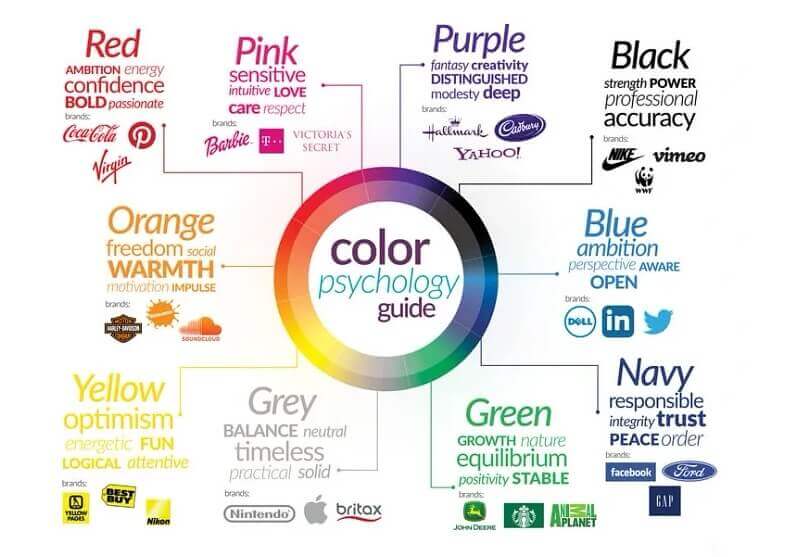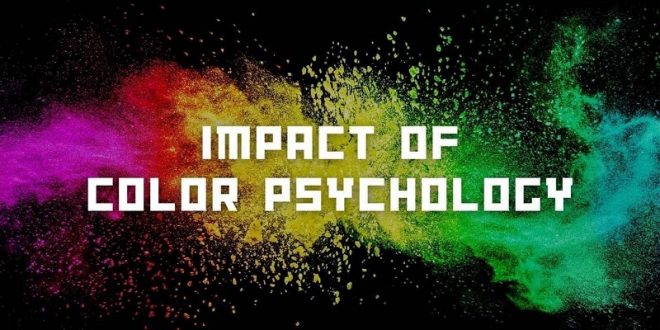By utilizing color psychology, we can gain insight into why and how people engage with certain brands. This powerful tool lets us create more impactful and enduring brand experiences for our customers.
What is Color Psychology?
Color psychology is a fascinating and complex field that examines the impact of different colors on human behavior and emotions. It is widely used in branding and marketing strategies as businesses seek to create a powerful visual identity that resonates with their target audience. Understanding the psychology of color can help a business choose the color scheme for its brand and marketing materials, which can influence customer perceptions, buying decisions, and overall brand recognition.
So, what is color psychology, exactly? Color psychology is the study of how various hues influence individual actions and feelings. Its concept is based on the idea that certain colors can evoke specific emotions and reactions in people. In contrast to blue, which is connected with trust, dependability, and tranquility, red, for instance, is linked to passion, joy, and risk. Commonly, people associate green with nature, growth, and harmony, while yellow can evoke feelings of optimism and happiness.
Colors can have different meanings depending on cultural, social, and personal contexts. For example, white, often associated with purity and innocence in Western cultures, represents death and mourning in Eastern cultures. Similarly, red is considered good luck in China but is related to warning signs and danger in the United States.

Color Psychology in Branding and Marketing Strategies
Incorporating color psychology into graphic design can help create a visual identity that reflects a company’s brand values and personality. Design templates and logo makers that use color psychology can assist businesses in creating professional and impactful designs that resonate with their target audience. By using design tools that consider color psychology, businesses can create designs that effectively communicate their message and capture the attention of potential customers.
For example, if a business wants to convey reliability and trustworthiness; it may choose a blue color scheme for its branding and marketing materials. If they want to invoke a feeling of excitement and energy, they may choose a red color scheme. Similarly, if they want to create a calming and peaceful atmosphere, they may choose a green or blue color scheme.
Using color psychology in branding and marketing strategies can also help businesses differentiate themselves from competitors. By choosing a unique color scheme that reflects their brand personality and values, businesses can stand out in a crowded marketplace and create a memorable visual identity that customers will remember.
However, it’s important to note that color psychology is not a one-size-fits-all solution. Different colors can have different meanings depending on the audience and context. For example, while red may be an effective color for a food brand looking to evoke feelings of hunger and excitement; it may not be the best choice for a healthcare brand looking to convey calmness and reliability.
Ultimately, incorporating color psychology into branding and marketing strategies requires a deep understanding of the target audience, brand values, and industry trends. By working with experienced designers and marketers, businesses can create a powerful and effective visual identity that resonates with their target audience and helps them achieve their business goals.
Here are some relevant statistics and fun facts related to color psychology in branding and marketing:
- According to a survey by the Pantone Color Institute, blue is the most popular color among men and women.
- Red is commonly used in food branding and marketing because it is associated with hunger and can stimulate appetite.
- Green is often used in environmental and natural product branding and marketing because it is associated with nature, growth, and sustainability.
- Yellow is commonly used in branding and marketing for children’s products because it is associated with happiness and playfulness.
- Black is often used in luxury and high-end branding and marketing because it is associated with sophistication and exclusivity.
- A study by the Journal of Business Research found that color can impact consumer purchasing decisions, with warm colors like red and orange evoking impulse buying behavior and cool colors like blue and green encouraging thoughtful consideration.
- The color scheme of a website can impact user experience and behavior, with colors like blue and green promoting calm and trust, and colors like red and orange evoking urgency and excitement.
- A survey by the web design platform Canva found that the most popular color schemes for branding and marketing are blue and green, followed by black and white.
These statistics and fun facts demonstrate the importance of understanding color psychology in branding and marketing. By choosing a color scheme for their brand and marketing materials, businesses can increase brand recognition, impact consumer behavior, and create a powerful visual identity that resonates with their target audience.
The Meaning Behind Colors and The Impact They Have on Brands
Color meaning is an indispensable element of branding and design; as it plays a vital role in shaping how consumers perceive and interact with a brand. Color psychologists have conducted extensive studies on the impact of color on human behavior and emotions. By comprehending the associations and feelings evoked by different colors, businesses can establish a robust brand identity, establish a deeper connection with their target audience, and influence consumer behavior in a meaningful way.
Colors are often associated with specific emotions and meanings that vary across cultures and demographics. Red, for instance, is linked to fervor, enthusiasm, and urgency. This makes it a popular choice for brands in the entertainment and food industries; where creating and giving off a feeling of excitement and urgency is essential. Blue, on the other hand, is associated with calmness, trustworthiness, and reliability. This makes it a popular choice for brands in the technology or finance industries, as trust and reliability are critical.
Psychology of Colors in Brands:

The color associations do not stop there. Happiness, optimism, and warmth are the emotions and meanings associated with yellow; making it a popular choice for brands in the hospitality and entertainment industries. Nature, health, and growth are the associations with green; making it a popular choice for brands in the health and wellness industries. Purple is a preferred color for firms in the fashion and beauty sectors because of its associations with comfort, innovation, and spirituality. Energy, enthusiasm, and warmth are the emotions and meanings associated with the color orange; making it a popular choice for brands in the food and beverage industries. Black is associated with sophistication, elegance, and power; making it a popular choice for luxury brands. Purity, simplicity, and cleanliness are the associations with the color white; making it a popular choice for brands in the healthcare and beauty industries.
By understanding the emotional associations and meanings behind different colors; businesses can use them strategically in their branding and marketing materials. For example, a restaurant might use red in its logo and decor to create a feeling of excitement and urgency around its food offerings. A health and wellness brand might use green to convey naturalness and vitality. A luxury fashion brand might use purple to evoke sophistication and creativity.
Using specific colors consistently across all branding and marketing materials can also help businesses create a recognizable and memorable brand image. The red and yellow color scheme used by McDonald’s is instantly recognizable and synonymous with the fast-food chain. The bright green and purple color scheme used by the energy drink brand Monster sets it apart from other drinks in the same category.
In conclusion:
In conclusion, the meaning behind colors and their impact on human behavior are critical considerations for businesses in today’s competitive marketplace. By understanding the emotional associations and meanings behind different colors, businesses can create a strong brand identity, connect with their target audience, and influence consumer behavior. Using graphic design tools, templates, and a logo creator, you can provide pre-set color schemes designed to convey specific emotions or associations based on the industry or niche of the business. By using color strategically, businesses can set themselves apart from competitors and create a lasting impression on their target audience. Therefore, businesses must take color psychology seriously and consider the impact of color on their branding and marketing decisions.

Understanding how different colors evoke emotions in audiences
Color psychology is the study of how colors can affect human behavior and emotions. Here are some examples of how different colors can evoke specific emotions in audiences:
- Red: Red is a color of passion, excitement, and urgency. It can also evoke feelings of aggression or danger, which can be effective in certain contexts. Food and entertainment companies often use red in their branding and marketing materials to create urgency or excitement.
- Blue: Blue is a color of calmness, trustworthiness, and reliability. It is often used by brands in the technology or finance industries; as it can create stability and security.
- Green: Green is native to nature, health, and growth. Also, you can use it to create wealth or luxury, as in the case of eco-friendly or high-end products. Brands in the health or wellness industries often use green in their branding.
- Yellow: Yellow is a color of happiness, optimism, and warmth. It is an evident choice for brands that want to create a feeling of positivity or playfulness; such as children’s brands or fast food chains.
- Purple: Purple is a color of luxury, creativity, and spirituality. It is an apparent choice for brands that want to create elegance or sophistication, such as beauty or fashion brands.
- Orange: Orange is a color of energy, enthusiasm, and warmth. Businesses that wish to evoke excitement or enjoyment, like sports or entertainment businesses, may find it to be a wise choice.
- Black: Black is a color of sophistication, elegance, and power. It is an effective choice for high-end or luxury brands; as well as brands that want to create authority or exclusivity.
- White: White color shows purity, simplicity, and cleanliness. White is an excellent option for companies in the technology or healthcare industries that wish to promote clarity or simplicity.
Importance of Colors in Branding and Designing:
When using color in branding and design; it is important to consider the emotions and associations that different colors can evoke in audiences. Design tools, templates, and logo makers often provide pre-set color schemes that are designed to convey specific emotions or associations based on the industry or niche of the business. By understanding the psychology of color; businesses can create a strong brand identity and connect with their target audience on a deeper level.
Why Color Psychology Matters for Companies and Brands
Color is one of the most powerful tools that companies and brands can use to influence consumer behavior and perception. The psychology of color is the study of how different colors can impact human emotions, behavior, and decision-making, and it plays a critical role in branding, marketing, and design.
Here are some reasons why color psychology matters for companies and brands:
Firstly, color can help create a strong brand identity. By using specific colors consistently across all branding and marketing materials; companies can create a recognizable and memorable brand image that stands out from competitors. For example, the red and yellow color scheme used by McDonald’s is instantly recognizable and synonymous with the fast-food chain.
Secondly, color can help communicate a brand’s values and personality. Different colors are associated with different emotions and meanings, and companies can use this to their advantage by selecting colors that align with their brand’s values and personality. For example, a health and wellness brand might use green to convey naturalness and vitality; while a luxury fashion brand might use purple to evoke sophistication and creativity.
Thirdly, color can influence consumer behavior and decision-making. Research has shown that color can impact everything from a person’s perception of product quality to their willingness to make a purchase. By using colors strategically in branding and marketing materials, companies can encourage desired behaviors and outcomes. For example, a blue “buy now” button on an e-commerce website may be more effective at converting sales than a red button.
Fourthly, color can help create a positive emotional connection with consumers. Brands that use colors that evoke positive emotions such as happiness, warmth, or excitement can create goodwill and trust with consumers. For example, a children’s toy brand might use bright, playful colors to create a sensation of fun.
Finally, color can help differentiate a brand from competitors. By using unique or unexpected color combinations, companies can stand out from their competitors and create a memorable brand image. For example, the bright green and purple color scheme used by the energy drink brand Monster sets it apart from other drinks in the same category.
Conclusion
The psychology of color is a critical consideration for companies and brands in today’s competitive marketplace. By understanding the emotional associations and meanings behind different colors, businesses can create a strong brand identity, communicate their values and personalities, influence consumer behavior, and create positive emotional connections with consumers. Design tools, templates, and also logo makers can offer pre-set color schemes designed to convey specific emotions or associations based on the industry or niche of the business.
By using color strategically, businesses can set themselves apart from competitors and create a lasting impression on their target audience. Therefore, companies and brands need to take color psychology seriously and consider the impact of color on their branding, marketing, and design decisions.
Short Bio:
Jenn Pereira is currently working as a Content Strategist at Kittl.com – an intuitive design platform that offers a range of tools, including an AI image and logo generator and a t-shirt maker. She has vast experience in user experience and developing effective strategies to meet users’ needs and expectations through content creation.
 free html design Free html design templates
free html design Free html design templates






